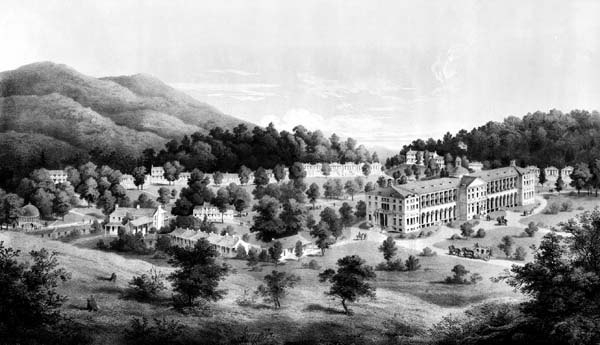White Sulpher Springs

Edward Beyer's famous lithograph of White Sulphur Springs was published in his 1857-58 Album of Virginia. When he visited White Sulphur,
Old White had not yet been completed, so Beyer sketched in the new hotel based on the architect's drawings.
Courtesy of the West Virginia State Archives.
On June 23, a high-water mark on the 15th hole of Old White—the historic golf course at The Greenbrier—was covered under at least five feet of water. The previous flood record was set 101 years ago, in 1915. Floodwaters from Howard’s Creek made their way into The Greenbrier for the first time in memory. In the community of White Sulphur Springs, people lost their lives and homes. Making matters worse, many local residents work at The Greenbrier, which was closed for two weeks during the cleanup. The resort eventually was opened as an emergency shelter for people left homeless by the floods.
Nestled in the Alleghenies nearly 2,000 feet above sea level, White Sulphur Springs is one the last great spring resort towns in Appalachia. While most communities in the region grew up around an extractive industry—coal, timber, oil, or gas—White Sulphur Springs owes its long existence to the most plentiful resource on the planet: water. The mineral springs in Greenbrier, Monroe, and Summers counties were once popular with travelers seeking to improve their health.
In the mid-1800s, Dr. John J. Moorman called White Sulphur’s water the “most highly medicated and efficient mineral water of its class in America, if not in the world.” As such, it became a trendy summer vacation spot for political and business leaders from Washington, Baltimore, and cities throughout the South. For the Southern elite, White Sulphur became the place to go, and the town of White Sulphur Springs grew around it.
Travelers began visiting White Sulphur in the late 1700s, and the community had its own tavern as early as 1808. In 1857, the cornerstone was laid for Old White, the first grand hotel on the site. A dozen years later, on June 30, 1869, the Chesapeake & Ohio Railway arrived. Trains eventually connected White Sulphur with literally any place in the country.
In 1910, the Chesapeake & Ohio Railway Company purchased the resort and opened a new hotel, The Greenbrier, in 1913. The Greenbrier would host presidents, Hollywood celebrities, dukes, and duchesses. Its history also took some unique turns. At the beginning of World War II, The Greenbrier was used temporarily as a prison for German and Italian nationalities. Afterward, the Army used the hotel as a hotel and recuperation center for soldiers known as Ashford General Hospital. The resort was redecorated by New York designer Dorothy Draper after the war and took on the look and feel it has today.
It’s tragically ironic that a town built for the curative powers of water was nearly destroyed by water. Several weeks after the flood, Howard’s Creek again flows peacefully past Route 60 and the back nine of Old White. While walking around town with Samantha Perry, a reporter from Beckley’s The Register Herald, White Sulphur Police Chief noted the now serene place where 14-year-old Mykala Phillips was swept away from her family. Then he pointed to the Nicely home and said solemnly, “They lost three folks: Hershel Nicely, his daughter Natasha Nicely, and Natasha’s son, Dakota Stone. Their house was washed away entirely.”
Sadly, we must add the flood of June 2016—and the lives lost in it—to the long history of a community known for bringing healing and happiness to its visitors.
You can read the rest of this article in this issue of Goldenseal, available in bookstores, libraries or direct from Goldenseal.